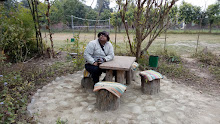Achyranthes aspera var. perphyristachya Hook F.
Prickly Chaff-flower-- An important medicinal plant !!
BOTANICAL NAME: Achyranthes aspera var. perphyristachya Hook F.
BOTANICAL NAME: Achyranthes aspera var. perphyristachya Hook F.
FAMILY: Amaranthaceae
ENGLISH NAME: Prickly Chaff-flower, devil's horsewhip.
HINDI NAME: Chirchita, Latjira, Onga.
SANSKRIT NAME: अपामार्ग (apamarga)
GENERAL DESCRIPTION: It grows as wasteland herb every where. Since time immemorial, it is in use as folk medicine. It holds a reputed position as medicinal herb in different systems of medicine in India. It is distributed throughout the tropical world. It can be found in many places growing as an introduced species and a common weed. It is an invasive species in some areas, including many Pacific Islands environments.
BOTANICAL DESCRIPTION:
>>plant: An erect or subscandent annual herb upto 1m high.
>>stem: Angular, ribbed, thickened above the node, more or less densely hairy.
>>leaves: Opposite, elliptic or obovate, form an acute or obtuse base, acuminate or rounded at apex.
>>flower: Deflexed, congested near the apex of the axis, perfect, bracts and bracteoles subequal.
>> fruit: An utricle, oblong-cylindric, truncate at apex, rounded at base.
>>seeds: Subcylinderic, truncate at apex, reddish brown.
>>flowering and fruiting: Sept. - Dec.
USEFUL PART: All parts
TRADITIONAL MEDICINAL USES: According to Ayurveda, it is bitter, pungent, heating, laxative, stomachic, carminative and useful in treatment of vomiting, bronchitis, heart disease, piles, itching abdominal pains, ascites, dyspepsia, dysentery, blood diseases etc. In Uttar Pradesh the plant is used for a great many medicinal purposes, especially in obstetrics and gynecology, including abortion, induction of labor, and cessation of postpartum bleeding.The Maasai people of Kenya use the plant medicinally to ease the symptoms of malaria.
AYURVEDIC PREPARATION:
>>Apamarga Taila, Agnimukha etc.
ENGLISH NAME: Prickly Chaff-flower, devil's horsewhip.
HINDI NAME: Chirchita, Latjira, Onga.
SANSKRIT NAME: अपामार्ग (apamarga)
GENERAL DESCRIPTION: It grows as wasteland herb every where. Since time immemorial, it is in use as folk medicine. It holds a reputed position as medicinal herb in different systems of medicine in India. It is distributed throughout the tropical world. It can be found in many places growing as an introduced species and a common weed. It is an invasive species in some areas, including many Pacific Islands environments.
BOTANICAL DESCRIPTION:
>>plant: An erect or subscandent annual herb upto 1m high.
>>stem: Angular, ribbed, thickened above the node, more or less densely hairy.
>>leaves: Opposite, elliptic or obovate, form an acute or obtuse base, acuminate or rounded at apex.
>>flower: Deflexed, congested near the apex of the axis, perfect, bracts and bracteoles subequal.
>> fruit: An utricle, oblong-cylindric, truncate at apex, rounded at base.
>>seeds: Subcylinderic, truncate at apex, reddish brown.
>>flowering and fruiting: Sept. - Dec.
USEFUL PART: All parts
TRADITIONAL MEDICINAL USES: According to Ayurveda, it is bitter, pungent, heating, laxative, stomachic, carminative and useful in treatment of vomiting, bronchitis, heart disease, piles, itching abdominal pains, ascites, dyspepsia, dysentery, blood diseases etc. In Uttar Pradesh the plant is used for a great many medicinal purposes, especially in obstetrics and gynecology, including abortion, induction of labor, and cessation of postpartum bleeding.The Maasai people of Kenya use the plant medicinally to ease the symptoms of malaria.
AYURVEDIC PREPARATION:
>>Apamarga Taila, Agnimukha etc.
>>According to Ayurveda, it is bitter, pungent, heating, a laxative, a stomachic, a carminative and useful for the treatment of vomiting, bronchitis, heart disease, piles, itching, abdominal pains, ascites, dyspepsia, dysentery and blood diseases (Flora of the Indian Desert, M.M. Bhandari. 287-88. 1990).
PHARMACOLOGY: Plant shows significant abortifacient activity in mice and rabbits. An n-butanol extract has been found to possess contraceptive efficiency in rats which might be assigned to its potent estrogenicity.
CHEMICAL CONSTITUENTS: >>Plant yields achyranthine.
>>Achyranthes aspera contains triterpenoid saponins which possess oleanolic acid as the aglycone.
>>Ecdysterone, an insect moulting hormone, and long chain alcohols are also found in Achyranthes aspera
OTHER USES:>>Useful for reclamation of wastelands.
>>Leaf is consumed as potherb.
>>Seeds rich in protein, cooked and eaten.
>>Used in religious ceremonies in India. It is one of the 21 leaves used in the Ganesh Patra Pooja done regularly on Ganesh Chaturthi day.
SOURCES:>>http://
>>http://
>>http://
>>http://
>>http://www.101herbs.com/
>>http://
>>http://
>>http://www.pfaf.org/user/
PHARMACOLOGY: Plant shows significant abortifacient activity in mice and rabbits. An n-butanol extract has been found to possess contraceptive efficiency in rats which might be assigned to its potent estrogenicity.
CHEMICAL CONSTITUENTS: >>Plant yields achyranthine.
>>Achyranthes aspera contains triterpenoid saponins which possess oleanolic acid as the aglycone.
>>Ecdysterone, an insect moulting hormone, and long chain alcohols are also found in Achyranthes aspera
OTHER USES:>>Useful for reclamation of wastelands.
>>Leaf is consumed as potherb.
>>Seeds rich in protein, cooked and eaten.
>>Used in religious ceremonies in India. It is one of the 21 leaves used in the Ganesh Patra Pooja done regularly on Ganesh Chaturthi day.
SOURCES:>>http://
>>http://
>>http://
>>http://
>>http://www.101herbs.com/
>>http://
>>http://
>>http://www.pfaf.org/user/

%5D+ban+tulsi.JPG)










0 comments:
Post a Comment